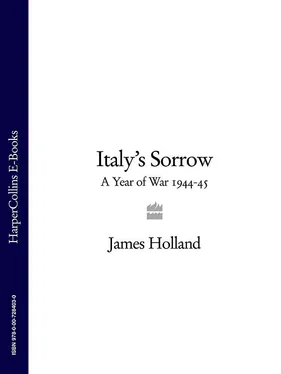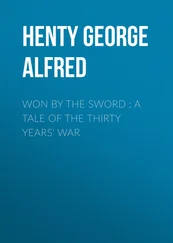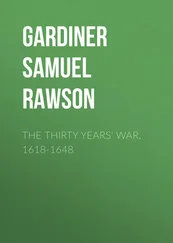That same Thursday in March 1944 was proving to be a significant day on the main front line as well. Just over sixty miles to the south-east of Rome, lay the town of Cassino, and towering above it, the remains of the sixth-century Benedictine monastery of Monte Cassino. Emerging from the high and jagged peaks that stretched east to the Adriatic coast and overlooking the flat Liri Valley before the mountains rose once more to the western coast, Monte Cassino held the key to the route to Rome and was the single most important point in the German ‘Gustav Line’, a defensive barrier than ran like a belt across the waist of Italy.
Since January, the Allies had repeatedly tried to force their way through, but the formidable defences had prevented them. Indeed, as the dust and debris of the blast in the Via Rasella began to settle that sunny spring afternoon, the Allies were about to call a halt to their third attempt to break Cassino and Monastery Hill above.
That the Allied attack was now almost beaten had much to do with the tenacious defending by the German 1st Parachute – or Fallschirmjäger – Division. Amongst these defenders was Hans-Jürgen Kumberg, a nineteen-year-old paratrooper born in Ventspils, Latvia to German parents. In 1939, as Russia was soon to occupy the Baltic States, the family moved to Posen in German-occupied Poland, and it was here, in June 1943, that Hans finished school. Inspired by a film about the Fallschirmjäger’s action over Crete in May 1941, he promptly, aged just seventeen, volunteered to become a paratrooper himself. Before Christmas, having successfully completed his training, he was posted to the Adriatic where the Fallschirmjäger were still defending Ortona. It had been a month since Hans and the division had arrived at Monte Cassino, in time for the Third Battle of Cassino.
The German defenders had fought with almost insane bravery and determination since the moment the Allies had landed at Salerno the previous September. Almost every yard had been bitterly contested as the defenders had fallen back across rivers, through mountains and networks of mines, booby traps and wire. Through November and December, they had successfully held the Allies at bay along the narrow Mignano Gap, a mere ten miles south-east of Cassino, before retreating in January to their well-prepared defences of the Gustav Line, along which Cassino was the key position. Helped by a particularly wet and cold winter, they had in that first month of the new year, and again in February, barred the Allies from bludgeoning their way through to the wider valley beyond that led to Rome. The first two battles of Cassino had seen some of the most bitter and bloody fighting of the war to date.
In the four long weeks since his arrival at Cassino, Hans had not had a chance fully to grasp just how high up he was in the mountains, or how dominant was the monastery that overlooked the Liri Valley below. His division had reached the town in the dead of night on 20/21 February. Arriving at the foot of Monastery Hill, they had then disembarked from their trucks and walked as silently as they could – despite their heavy packs and equipment – up through a steep gully to a ridge about a mile beyond and above the remains of the monastery. It was wet underfoot and bitterly cold and the climb a difficult one; yet, whatever the difficulties of hauling equipment and supplies high into the Cassino massif, there was no denying that such an imposing landscape was an enormous advantage to the defender. Monastery Hill itself rose sharply from the town below, standing sentinel and, at 700 feet, a formidable feature for any attacker. Compared with the range of mountains stacked behind it, however, Monastery Hill was just that – a hill – dwarfed by the 5,475-foot-high giant that was Monte Cairo.
In the Liri Valley, the defenders had smashed dikes and diverted water courses to flood large parts of the valley floor and so make it impassable to vehicles, especially heavy trucks and tanks. South of the valley, as far as the sea fifteen miles away, were more mountains: the Aurunci range rising to 5,000 feet – almost as high as the mighty range of the interior. It was along these positions that German engineers and their Italian press-ganged labour force had built a network of bunkers and gun emplacements and laid intricate webs of wire and mines. And it was from here that the defenders had blocked the Allied advance to Rome for more than two months.
When daylight broke the following morning, Hans could just about see the scree-like ruins of the monastery emerging through a thick mist, but the valley floor below and Monte Cairo behind remained completely hidden. As Hans was soon to discover, he had come to one of the most desolate and violent places in the world. The hard rock and precipitous slopes of the mountains and the flooded valley below had blunted the Allies’ superior fire power. At Cassino, each yard – each foot – had to be won or defended by the men unfortunate enough to find themselves thrown into this battle of attrition.
The monastery had been just one of the victims, obliterated by the Allies a week before Hans’ arrival. Other victims from the previous months’ fighting lay scattered and strewn in front of Hans’ machine-gun post; the dead were everywhere. The stench of rotting corpses, bloated and noxious, was overpowering. Hans’ regiment occupied a small ridge known as Hill 445, some 400 yards to the north of the obliterated monastery. By day, Hans and his comrades remained at their post, the constant smoke and dust from shellfire and from British fog canisters shrouding the top of the mountain. By night, they would be able to cautiously slink their way back to the ruined farmhouse that served as company headquarters, or back down the hill to collect ammunition and supplies.
Although Hans’ arrival had coincided with a lull in the fighting, shell and mortar fire, bombing and sniping continued incessantly. Neither side could ever afford to relax; as the German paratroopers had soon learnt, they had to be on their guard at all times. Opposite them were the 1/9th Gurkha Rifles, notorious for their proficiency with kukri knives. Sometimes at night, when less ordnance was hurled back and forth, Hans could hear the screams of his fellow paratroopers as Gurkhas stealthily infiltrated a German outpost, killing – often decapitating – the men with their curved knives. Hans and his comrades hardly dared sleep at night for fear of meeting such a fate: on edge all the time, the strain was immense.
A week before, the battle had begun again in earnest. The morning of 15 March had been clear and sunny, but at around 8.30 a.m. Hans and his unit heard the sound of massed aero engines and then watched open-mouthed as the sky filled with Allied aircraft. They had come to pulverise Cassino town: nearly 800 planes in all, dropping over 1,000 tonnes of bombs. When they had gone, and the dust had settled, the town lay utterly and completely destroyed. The ruins had since proved easier to defend than when the town had been standing, as the New Zealand troops sent in afterwards had discovered at great cost – the Corps losing around 4,000 men. At the same time, the British 4th Indian Division had failed to make headway around Monastery Hill. Hans-Jürgen Kumberg and his comrades had fought hard and valiantly – and had even earned a certain respect from their enemy, who had started to refer to the paratroopers as the ‘Green Devils’.
That evening, 23 March, the British general, Sir Harold Alexander, Commander-in-Chief of Allied Armies in Italy (AAI), drove up to the front line to see the battlefield for himself. The New Zealand commander, General Freyberg, and the US Fifth Army commander, General Mark Clark, had both recommended that the Third Battle of Cassino be called off without delay. Agreeing that any further offensive action was indeed futile, Alexander concurred. The Germans had scored another defensive victory. Difficult though it was to accept in this age of highly mechanised modern warfare, the harsh winter conditions and formidable natural defences of this thin, mountainous country had ensured that the Allies would henceforth have to return to the old summer campaigning season of centuries past.
Читать дальше











